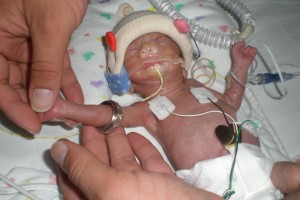CHOC has made significant strides in improving future prospects for babies with extremely low birth weights (ELBW), according to recently released three-year data from its Small Baby Unit (SBU).
This data shows a notable shift in outcomes for patients discharged in 2012, compared to those discharged in 2009, before the opening of the 12-bed unit for infants born at less than 28 weeks gestation or smaller than 1,000 grams:
• Weight and head circumference: In 2012, just 16 percent of all infants discharged from the unit were below the third percentile for weight and head circumference, while 39 percent were in 2009. These factors are linked to cognitive and physical disabilities.
• Oral feeding rates: In 2012, 84 percent of infants were being fed completely orally upon discharge, compared to 65 percent in 2009. CHOC’s SBU practices infant-driven feedings, wherein the baby drives her own advancement of nipple feeding – not staff.
• Infection rates: In 2012, 15 percent of infants suffered late infections, while 41 percent did in 2009. The SBU attributes this dramatic shift to a team approach, a reduction in central lines and excellent hygiene among staff and families.
• Chronic lung disease rates: In 2012, 27 percent of infants left the unit with chronic lung disease, compared to 45 percent in 2009. This common condition for premature babies can have long-lasting ramifications including re-hospitalization and poor neurodevelopment. Related, in 2012, 11 percent of infants went home from CHOC’s SBU on oxygen support, while 32 percent did in 2009.
• Labs and X-rays: The numbers of labs and X-rays have each been reduced by about half since 2009.
The unit opened in 2010. Though preterm infants were already receiving exceptional care in the NICU, CHOC physicians recognized that increasing medical literature-based efforts could improve outcomes for this unique patient population.
Specifically, research indicates that ELBW infants could greatly benefit from guideline-driven care provided by dedicated and specially trained staff inside a low-stimulus environment.
Three years later, the SBU is doing just that.
There, patients lie inside shrouded incubators that keep light away from their underdeveloped eyes. Even a whisper is harsh for these babies’ ears, so families and staff members speak in a gentle “library voice.” The goal is to mimic the womb’s environment as closely as possible so that infants can focus on growing.
“We’ve created this really unique place that only a handful of hospitals have,” says Dr. Antoine Soliman, the unit’s director.
But the space is equally nurturing for the parents of these tiny babies. Here, they find solidarity and support as they bond over an experience most parents cannot understand.
“We grew a bond, and we’re still very close. They are my family,” says Eunice, who became close with other parents during the three months her daughter, Emma Faith, spent in the SBU. “We understand each other.”
Now, Emma Faith, who weighed 1 pound and 4 ounces at birth, is an active and feisty 3-year-old. With no signs of physical or cognitive disabilities, she is living up to her nickname earned in the SBU: Mighty Mouse.
“She is our true miracle and pride and joy,” Eunice says.
Further, staff satisfaction continues to improve. Ongoing surveys reveal significant improvement in staff satisfaction and clinical outcomes of babies with extremely low birth weights; personal satisfaction and accomplishment; and opportunities to enhance skills and knowledge.
Moving forward, the SBU’s goal is to continue to improve patient outcomes, as well as family and staff satisfaction, while also becoming a destination for the care of extremely preterm infants.






